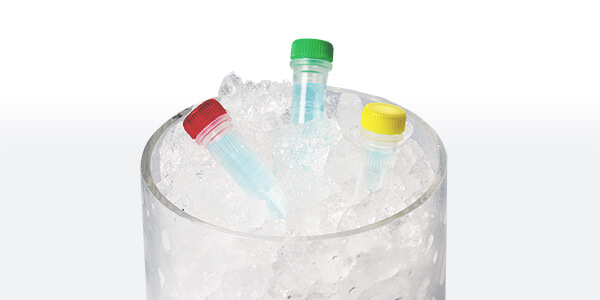
Safe freezing – reliable storage
The processing of your sample has worked perfectly and you have some more aliquots you would like to freeze at -80° C.
Friday afternoon, 8 p.m., your experiment took more time than expected and your samples should be stored at -20° C over the weekend.
The 1-litre bottle with media is rather inexpensive but also quite inconvenient to handle. What could be more logical than to store the media in smaller tubes in the fridge?
How annoying if you notice after some days or weeks that your storage tube has leaked, cracked or broken completely. The sample is gone, your media contaminated, the fridge soiled and the work of many days has all been for nothing. To prevent this from happening, we would like to give you some hints for freezing samples in our Sarstedt tubes.
What is happening in the tube?
Storing aqueous solutions like buffers, sample preparations, media, culture or reagents at temperatures below 0° C is required for many applications. These solutions expand while freezing. The volume increase causes pressure in the closed tube. If the pressure cannot spread inside the tube it strongly affects the tube walls spotwise which, at worst, might even crack.
What happens with the tube?
A high break resistance and impact strength are the outstanding advantages of plastic tubes over glass tubes. Especially polycarbonate and polypropylene are very durable against mechanical and thermal stress. At temperatures below 0° C, however, the strength values of plastic materials decline – they can crack more easily or break. Therefore, deep-frozen tubes should only be exposed to mechanical stress like centrifugation or vortexing only after thawing.
How to freeze tubes safely?
Freezing the content from bottom to top is crucial for safe freezing. For low-risk freezing, the tubes should be stored in a rack or box in an upright position. Sufficient free play in all directions allows cold air to circulate around the containers. The tubes can easily expand across their entire length and be removed from the boxes even in a frozen state. Screw caps ensure the safe closure of the tube.
What should be avoided?
Although Styrofoam containers provide a good protection of the sample they are not ideal for deep-freezing due to their insulating properties. If the cold air only reaches the upper part of the tube while the lower section remains protected, an ice clot may form. Impeded pressure balance is likely to produce cracks in the lower section.
Maximum filling of the tube may lead to a highly increased inner pressure as well. An air cushion provides space for the expansion of the freezing liquid.
Tubes which are stored in liquid nitrogen can explode while thawing due to nitrogen expansion. Therefore, storing in the liquid nitrogen phase – also with a view to contamination risks - should be avoided. For the storage in the gaseous phase of nitrogen, the special CryoPure tubes can be used. The optimized cap design enables the pressure to adjust during freezing and thawing, and provides increased safety for nitrogen storage.
Challenging compounds – what could be helpful?
Some liquids tend to freeze very rapidly so that they expand very abruptly or irregularly. Slow freezing in several steps – e.g. at -20° C for 24 h followed by storage at -80°C, or in special insulating containers allows the sample to freeze slowly, and preserves both the sample and the tube material.
Conclusion
As the stress exerted on the tubes tends to vary significantly depending on many factors like the sample type, the liquid composition, the tube used, the freezing method or the freezer, a freezing test for the special application is imperative. However, with due consideration of some handling tips, the risk of a broken or leaking tube can be avoided.
A summary of these notes can be downloaded here. You can find further tips for freezing in our CryoPure tubes in our User Guide “Safety Instructions and User Guide CryoPure”.

